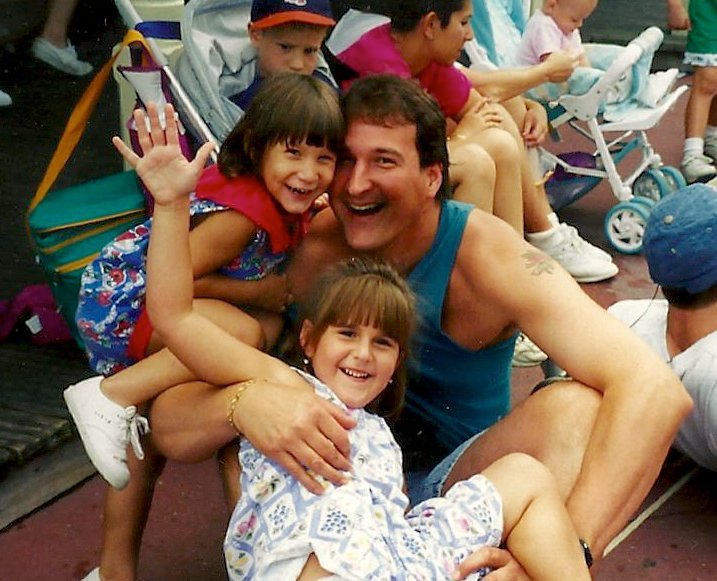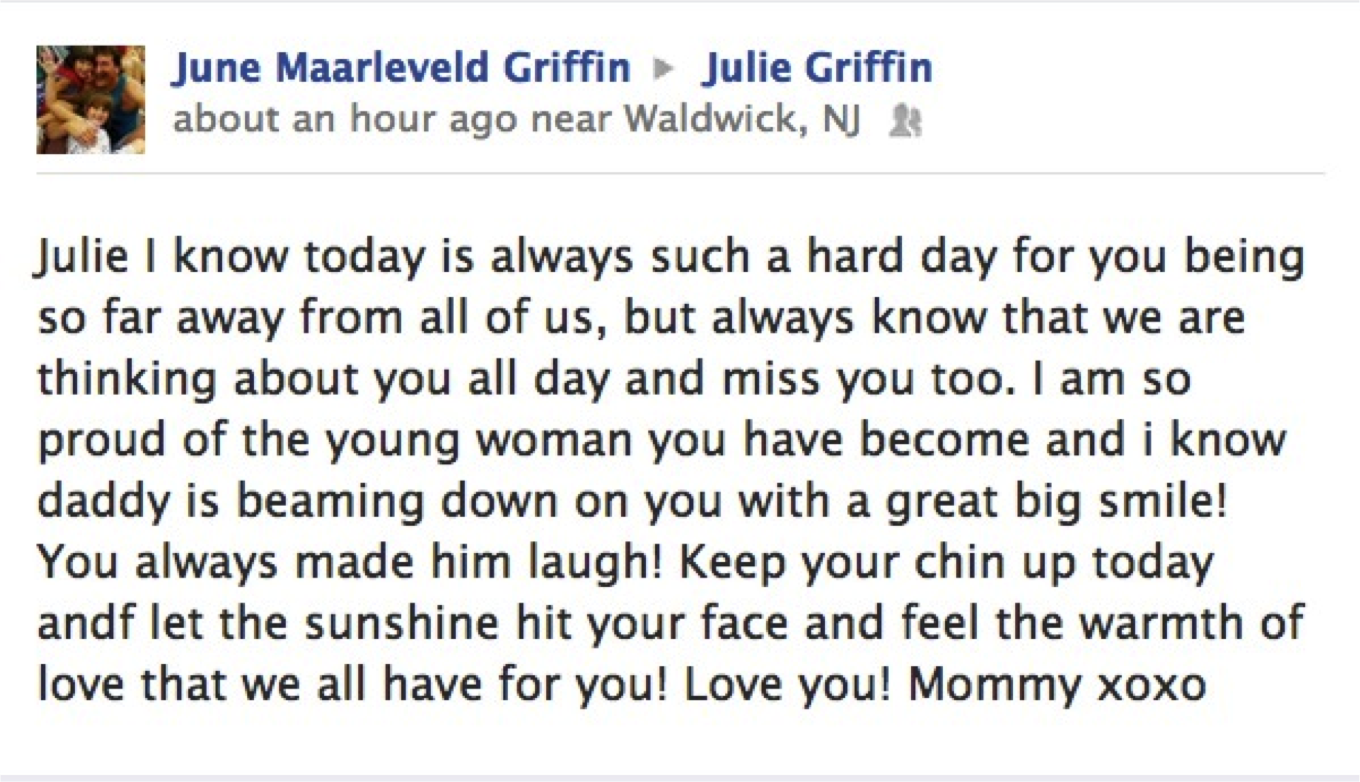I originally wrote this remembrance of my high school classmate 17 years ago, on September 11, 2006, at Terra Sigillata on ScienceBlogs.com. It has appeared in various forms on several sites, but this is the only place where you can still share your comments.
Let me tell you about John Michael Griffin, Jr.
Griff, as he was known in high school, was a friend of mine.
Late in the first half of our lives, he stood up for me physically and philosophically, for being a science geek. John’s endorsement was the first time I was ever deemed cool for wanting to be a scientist.
Griff died an engineer and hero in the collapse of one of the World Trade Center towers five [now 22] years ago today.
We lost touch almost twenty years before, but his kindness and friendship formed not only one of the cornerstones of the scientific life I have today, but in the person and father I have become as well.
—–
At a northern New Jersey Catholic high school in a predominantly Irish town, being a gangly Polish boy from two towns over was not the formula to cultivate one’s popularity or self-preservation.
Throwing the curve in biology and chemistry classes didn’t help either, nor did being a David Bowie fan in a place where Bruce Springsteen was as revered as St. Patrick. That’s probably where the nickname, “Zowie,” came from – the name of the glam rocker’s first child.
Worse, I had skipped a grade in elementary school, and being a year behind physically was not compatible with self-preservation during high school gym class.
But, it was a very simple gesture, sometime in junior year, when one of the packs of scoundrels had me cornered, slamming me against the wall and throwing my books down the hallway. I believe that the offense was that our biology teacher had taken to buying me a Pepsi every time I scored 100 on one of his exams, and I had been enjoying yet another one.
John, already well on his way to his adult height of 6′ 7″ or 6′ 8″, stepped in and said, “Hey, lay off of Zowie. He’s goin’ places.” And with that, the beatings stopped.
I didn’t play sports, at least not any of the ones offered by our school. At that time, soccer hadn’t taken off in the States but I was a huge player and had met John at Giants Stadium in the NJ Meadowlands where I had season tickets (Section 113, Row 7, Seat 26) for the relocated New York Cosmos. At just $4 a ticket for kids 16 and under, I could afford season tickets to see some of the greatest international soccer stars of the late 20th century: Germany’s Franz Beckenbauer, Italy’s Giorgio Chinaglia, Yugoslavia’s Vladislav Bogiçeviç, and, of course, Brazil’s great Pelé.
All accounts of John as an adult include his devotion to the Giants, NY Rangers, and NY Yankees, but few recall those soccer days. John’s family were long-time Giants season ticket holders and probably got their Cosmos season tickets three rows behind me as some sort of promotional giveaway. I recall that John was surprised that a science dork such as I would be cool enough to know about soccer and come to games myself, my father dropping me off outside the gates so he could go home and watch his beloved football games.
But, we Jersey boys loved soccer at a school where American football and basketball reigned supreme. Many Saturday and Sunday afternoons were spent at the massive stadium during soccer’s American heyday of the late 1970s, with crowds of 50,000 to 75,000 that have yet to be matched today.
—–
Among John’s gifts was the ability to make anything fun and to make anyone laugh. I recall sitting with him in a ski lodge in Amsterdam, NY, as I was recovering from frostbite during an ill-prepared class trip ski weekend. He pulled me into an imaginary board game with a napkin dispenser, where he pretended each napkin contained a message as to how to proceed during each turn. We looked at each other in horror when the waitress came unannounced and cleared our table of the napkins.
As a teenager, John was a physical caricature, handsome but a goof, self-effacing but self-confident, and had a clever and caustic wit, both of which he carried into adult professional life and fatherhood. His 15 Sept 2001 missing notice in the Bergen (NJ) Record noted that schoolkids called him, “Barney,” to reflect how they flocked to his presence.
No one was safe from John’s good-hearted and bombastic comedy routines. My father was nicknamed, “Groucho,” by John due to the resemblance of his thick mustache to that of the 1930’s comedian – John would burst spontaneously into seemingly classic Marx Brothers riffs, but with the content imitating my father carrying on about some printing press mishap.

My last remembrances of John are half a life away, from the impromptu high school graduation party he called at my house to his pride at finishing his engineering degree and managing facilities for a million-square foot building in Manhattan.
Perhaps he protected me as a kid because he knew that way deep down, he was destined to become an engineering geek himself. And a hero, a much bigger hero, in protecting the lives of others in a very real way.
—–
On the glorious fall morning of 11 Sept 2001, I was fixing coffee for my wife who had been sleeping in when the newsreader on my pager announced that a jet had struck the south tower of the World Trade Center.
I had missed my recent 20-year high school reunion and had not known that John had only months before been appointed director of operations at the WTC by Larry Silverstein’s, Silverstein Properties.
I did not learn until two weeks later that John had facilitated the escape of dozens of workers, handing out wet towels so people could breathe on their way down the stairs. In the 102 Minutes book by New York Times writers Jim Lynch and Kevin Flynn, John is immortalized in the corroborated account of the elevator rescue of 72-year-old Port Authority construction inspector, Tony Savas.
When he returned to 78, Greg Trapp saw a group of three Port Authority employees at work on the doors to the elevator where Tony Savas, a seventy-two-year-old structural inspector, was trapped. Trapp peered into the small gap and saw him, a man with thinning white hair, seemingly serene. One of the workers grabbed a metal easel, wedging the legs into the opening, trying to spread the doors from the bottom, where they seemed to have the greatest leverage. But their efforts had the opposite effect at the top of the doors, which seemed to pinch tighter.
At that moment, John Griffin, who had recently started as the trade center’s director of operations, came over to the elevator bank. At six feet, eight inches tall, Griffin had no problem reaching the top of the door to apply pressure as the others pushed from the bottom. The doors popped apart. Out came Savas, who seemed surprised to find Griffin, his new boss, involved in the rescue. Savas seemed exhilarated, possessed of a sudden burst of energy, rubbing his hands together, or so it seemed to Trapp.
“Okay,” Savas said. “What do you need me to do?”
One of the Port Authority workers shook his head. “We just got you out-you need to leave the building.”
No, Savas insisted. He wanted to help. “I’ve got a second wind.”
John and Mr. Savas stayed behind.
John’s wife, June, sweetheart of the class behind us, was quoted in John’s NYT, Portraits of Grief:
“He was at the back of about 30 people they were evacuating,” his wife, June Griffin, related from the accounts of survivors. “He had been in fires before — he should have gotten out.”
Mrs. Griffin speculated that her husband, instead of running for the exits, headed for the fire control center, where his training as a fire safety officer would have directed him. “He was an engineer,” Mrs. Griffin said. “He must have thought, ‘Buildings don’t just fall down.’”
John also left two daughters, both now teenagers, his parents, a younger brother and older sister, and literally hundreds of friends.
Not just any friends, either – anyone who knew John still says that when he talked with you, it was as though you were the most important person in the world.
—–
Leaving New Jersey in the mid-1980s and running on the tenure-track treadmill 1,600 miles away caused me to stop living life and lose track of a great many friends. I am deeply saddened not to have known John as an adult, a devoted husband and, by all accounts, a remarkable father.
Since John’s death, we’ve all found a little more time in our schedules to make time for one another. As the father of a little girl conceived in the months after the terrorist attacks, I try to respect June’s privacy and just send little gifts for the girls every so often. I cannot imagine how they and nearly 3,000 other families deal privately with the most public of tragedies.
I finally worked up the guts to go to Ground Zero [then] two months ago for the first time. Despite all the bickering about what the memorial should look like, there is a small memorial area set up in the interim. John’s name sits at the top of one column of names on the placards commemorating those lost.
He’ll always be at the top of my list.

2012 Postscript
This picture also appeared in 2011 when John’s younger daughter, Julie, now 20, was interviewed for the Waldwick (NJ) Suburban News by Jody Weinberger.
Julie’s memory of the events that took place on 9/11 is spotty. She was a fourth-grader at Crescent Elementary School when relatives came to take her and Jenna home.
“It was kind of chaotic,” Julie recalls, sitting on a stool in her kitchen. “Even though people were saying things, I didn’t know what they were talking about. I didn’t know what terrorism was and not even adults could really grasp what was happening.
“My grandpa came up to me and told me bad people did something to where my dad worked and that’s all I could really grasp at the time.”
After discussing her father’s rescue of Mr. Savas, Julie shared more of her mixed feelings:
“But then I think he actually went back to help more people and I think that’s when the buildings collapsed,” Julie said. “I was kind of angry knowing that he went to go save other people instead of thinking about coming home to his family. That bothered me but now I know he’s a hero.”
As the 10th anniversary of 9/11 approaches, Julie thinks about just some of the many moments she’s missed not having her father around.
“People think that it’s just the anniversaries, birthdays and holidays, and it’s true, those really are hard times, but every day [you have to] keep your head up and think positive,” she said. “It’s little things like learning how to drive and applying for college, or my first day of college that you just kind of wish he was there for, and you just have to keep going, I guess.”
Julie feels that by going after her dreams – which currently means graduating from the University of Tampa and pursuing a career in elementary education – she is making her father proud.

That Facebook post from June was from 2012. In 2013, we heard directly from Julie Griffin in a brave article she wrote for the national website of Kappa Alpha Theta, “Overcoming tragedy with the help of my sisters.”
2023 Postscript
I’m now back at the University of Colorado School of Pharmacy and it just struck me while doing orientation for my MS in Pharmaceutical Sciences students last month that many were born the year of the 2001 terrorist attacks. And since I last updated this post, we’ve lost four more of our 75 classmates in the SMHS Class of 1981 due to diseases of aging: brain cancer (Benn O’Hara), heart disease (Joe Mehos), stroke (Debbie Calviello), and too much Southern barbecue (Dan Doherty).
This coming Friday night, at St. Mary’s High School in Rutherford, NJ, a group of my classmates, other friends, and my sister, Sandi, run a scholarship fundraising party in John’s honor and memory called, Griff Rocks On. John’s wife, June, and others talk about John below. If you’re so moved, you can buy tickets to attend or make a donation to the John Griffin 9-11 Foundation on Venmo.
At 10:56 to 11:53, in a shot with the late Benn O’Hara, Dennis Van Dyk said it best: “John wouldn’t have forgotten any of us.”
Finally, John’s daughter Julie just posted this morning a Facebook reel with family pictures I’d never seen before – to the tune of “When God Made You My Father,” by Riley Roth. Thank you so much for sharing, Julie.






















